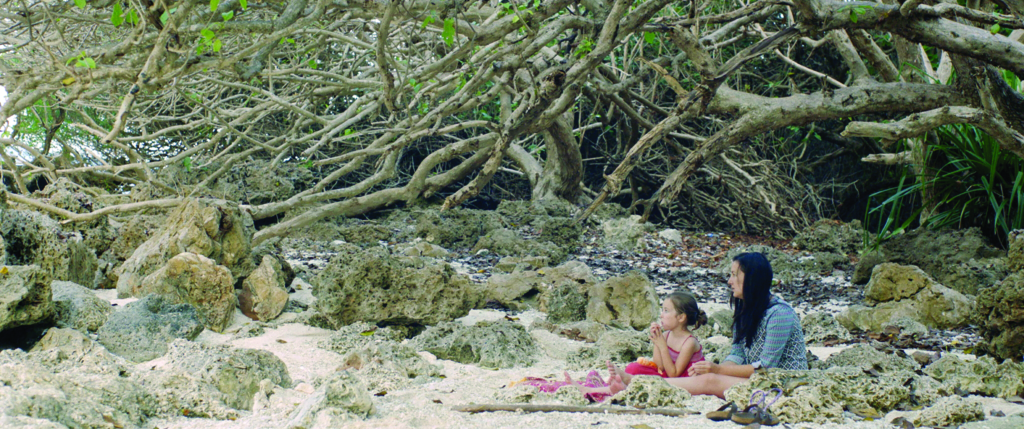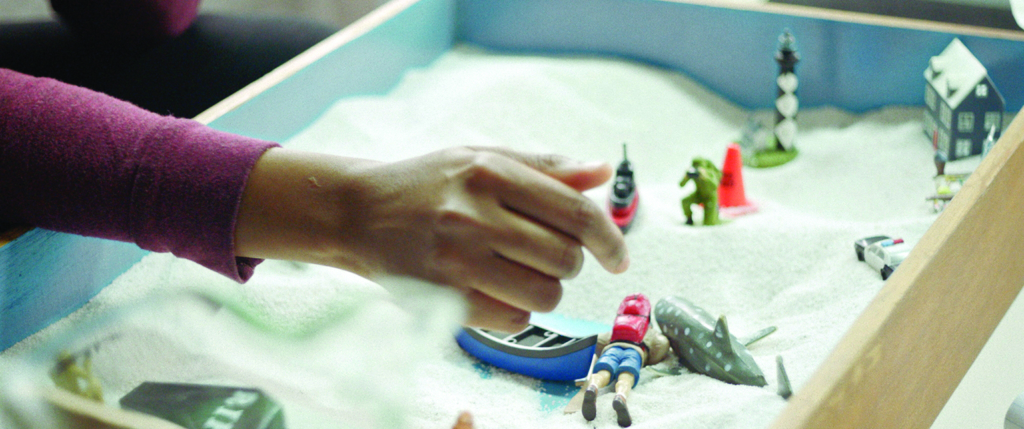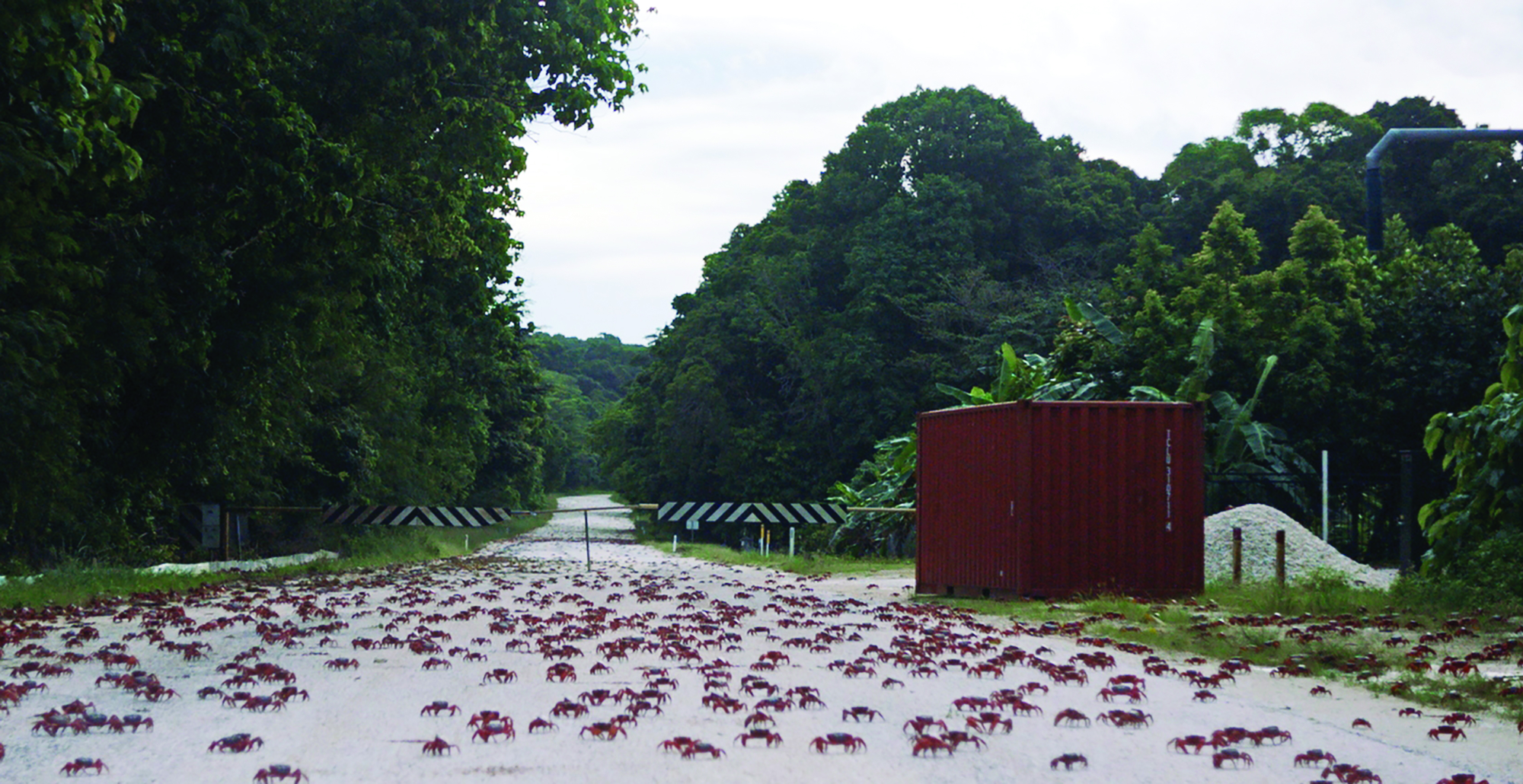There’s a developmental stage in toddlerhood so universal that it’s essentially a comic trope. Moving from the primitivism of infancy towards higher brain functions, the small child is a sponge, soaking up everything they can about the world around them. And their research methods can be summed up in a single word: ‘Why?’ Though parents and carers can find these infinite inquiries maddening – and feel like this question–answer dynamic is a one-way street – this ‘why’ phase gets at the intellectual curiosity that’s a bedrock of humanity. And, in turn, the best ‘why’ questions can function as challenges to the beaten-down adult’s acceptance of assumed truths or the status quo, causing the world to be looked at with the fresh eyes of a child.
This type of child–parent exchange occurs throughout Gabrielle Brady’s documentary Island of the Hungry Ghosts (2018). It’s a cine-portrait of Christmas Island, where its main (human) subject, Poh Lin Lee, works as a trauma therapist for those in indefinite detention. Lee also has two young girls, Poppy and Albertine, and their ‘why’ questions often echo the film’s own. If you’re wondering where its poetic title comes from, it’s taken from a month-long local celebration during which offerings are given to the ‘lost’ spirits still on the island: those who’ve died, but have yet to pass through to the next realm. When asked – of course – why, Lee, in explanatory mother mode, offers: ‘They make these offerings so that the ghosts are happy, and the ghosts don’t go and bother other people.’
But the most notable, trenchant ‘why’ questions arise from the fact that this tiny island – covered almost entirely by rainforest, ringed by reefs and with a population of under 2000 – is the site of a detention centre. Built by the Australian Government in 2006, at a (taxpayer-funded) cost of A$400 million,[1]Justin Gilligan, ‘Island on the Edge’, ECOS, issue 159, 9 March 2011, available at <http://www.ecosmagazine.com/print/EC10072.htm>, accessed 18 October 2018. it’s an Orwellian fortress on an otherwise-idyllic isle: hidden in the middle of the jungle, on land civilians are forbidden from visiting. If anything is going to raise the question ‘why’, it’s this compound. And, though Lee’s children begin with asking why you can’t camp near the detention centre, the inquiries suggest bigger questions, at a grander, sociopolitical level: Why are people locked up in there? Why is there a detention centre at all? Why have we allowed this to happen?
Brady’s documentary gains its power from suggesting questions, not supplying answers. It isn’t a journalistic investigation into life in detention centres, but a hybrid documentary full of lingering imagery, poetic voiceovers and moments that feel more like experimental narrative than nonfiction observation. Its key cinematic device is that of simple, unexplained contrast, depicting different forms of migration and transience, finding thematic richness in the juxtaposition.
On the island, individuals seeking asylum in Australia were, until recently, detained indefinitely, mired in inhumane stasis. The original immigrants to the island, the Malay and Chinese brought to mine phosphate in the early twentieth century, became the ‘ghosts’ of the title. As indentured workers operating under slavish conditions, none were afforded proper burials, modern-day locals believing that this doomed their souls to wander eternally, forever lost.[2]See Ryan Emery, ‘Gravestones Reveal Christmas Island’s Long Chinese History’, SBS News, 24 February 2016, <https://www.sbs.com.au/news/gravestones-reveal-christmas-island-s-long-chinese-history>, accessed 18 October 2018; and Autlook Films, Island of the Hungry Ghosts press kit, 2018, p. 2. In contrast to these victims of arrested passage, the free migration of Christmas Island red crabs, in their teeming millions, dominates the landscape. Local park rangers and residents are deferential to the crabs: roads are closed, traffic halted, all so that the creatures can, as the moon changes from full to new, travel from forest to sea.[3]Rachel Sullivan, ‘Red Crabs Overtake Christmas Island’, ABC Science, 3 November 2010, <http://www.abc.net.au/science/articles/2010/11/03/3055149.htm>, accessed 18 October 2018.

Brady first came to Christmas Island on holiday. In her early twenties, she was working in the backrooms of breakfast television, producing and writing for Sunrise in Sydney, and hating every minute of it. Compelled by ‘an instinct to get as far away from the reality that [she’d] experienced’ as possible, Brady explains in interview, she left in 2007, via an Australian Youth Ambassadors for Development program, to work in Mongolia’s TV industry, directing and producing a show (VoiceBox) for and about teenagers. In Ulaanbaatar, Brady met Lee, who was working in domestic-violence counselling. Over the years, as both wandered, they remained friends. After Mongolia, Brady worked in the remote central Australian Indigenous community of Yuendumu, and studied at Cuba’s Escuela Internacional de Cine y Televisión. When Poppy, Lee’s first child, was born in Benin in 2010, Brady came to visit. And, when the filmmaker was living in Jakarta a few years later, she was invited by Lee to come visit her family on Christmas Island, which is far closer to Java than to mainland Australia.
Brady’s first experiences of Christmas Island were, thus, as tourist: she went diving, snorkelling, hiking. She filmed some scenes of trauma counselling at Lee’s insistence, the latter sure that the service was about to be shut down, that the work she’d been doing would suddenly vanish into the unknown. They talked about making a film, a product of their friendship. But the idea was only catalysed when Lee – machete in hand – led Brady, and camera, tramping through the wild jungle, climbing through overgrown vines to ascend a lookout. It was there that they could see the dark heart, the hidden secret, of this paradise: the detention centre.
‘The reason there are offshore detention facilities is so we’re not faced with it. And the more distance we have [from] what’s going on, the easier it is to allow it to continue.’
—Gabrielle Brady
That Brady had been enjoying a holiday so close to this site of state-sanctioned perdition struck the filmmaker with a guilt familiar to many Australians. ‘That was the really shocking moment to me: that even I, someone who knew what Poh Lin’s work was, who was right there on the island, could forget that [the detention centre] exists,’ Brady says. The symbolism of this jungle prison was, in turn, all too potent. ‘[It’s] the way the whole system has been constructed,’ she continues. ‘The reason there are offshore detention facilities is so we’re not faced with it. And the more distance we have [from] what’s going on, the easier it is to allow it to continue.’
From this moment, Island of the Hungry Ghosts grew: an indirect indictment of a human-rights horror show, told with a sense of cinematic poetry and a sustained air of gathering dread. From the start, Brady knew that she didn’t want to make a regular documentary (‘I’m not interested in talking heads,’ she spits), setting out, instead, to make a movie that dwells in the ‘grey zone’ between fact and fiction. The things that inspired the film were eclectic, and noticeably not documentaries: JM Coetzee’s 2013 book The Childhood of Jesus, for its study of decontextualisation in both theme and delivery; Apichatpong Weerasethakul’s Uncle Boonmee Who Can Recall His Past Lives (2010), for its jungle imagery and movement of spirits; The Headless Woman (Lucrecia Martel, 2008), for its ‘sense of the creeping uncanny’; and Stop the Pounding Heart (Roberto Minervini, 2013), a film that scripts drama into real-life settings. The last of these is an example of hybrid filmmaking, a form Brady proselytises; the hybrid movie’s lack of distinction between the staged and the ‘real’ means that – to put it in Herzogian terms – the ecstatic truth can prevail over the accountant’s truth.[4]See Werner Herzog, ‘Minnesota Declaration’, 1999, Werner Herzog official website, <http://www.wernerherzog.com/complete-works-text.html>; and ‘On the Absolute, the Sublime, and Ecstatic Truth’, trans. Moira Weigel, Arion, vol. 17, no. 3, Winter 2010, available at <https://www.bu.edu/arion/on-the-absolute-the-sublime-and-ecstatic-truth/>, both accessed 18 October 2018.

Speaking about this approach leads Brady to her own ‘why’ questions. ‘Any film is a construct,’ she explains, ‘[so] why wouldn’t you want to open up techniques you can pull from both the fiction world and the documentary world?’ This holds true when Brady details the elements of the film: Michael Latham’s work as cinematographer, which tends more towards dreaminess than realism; Leo Dolgan’s sound design, which employs a palette of island noises (crabs scuttling en masse, buzzing insects, wind in trees, waves on sharp rocks) as compositional elements, ambience used to convey ‘this feeling of growing threat’; and Aaron Cupples’ score, which uses hand-built instruments that evoke both experimental sound art and the traditional Chinese instruments of the Hungry Ghost rituals. ‘So often, in documentaries, the craft in each element isn’t given the same significance as it is in fiction,’ Brady offers. ‘Why? Why should it be like that?’
Island of the Hungry Ghosts lays down its hybrid gauntlet from the start. Opening with a ‘prison break’ sting, in which a man, under the cover of night, escapes over a chain-link fence – fleeing through the forest, screaming, as dawn breaks – the first sequence feels more reminiscent of a commercial neo-realist thriller like Night Moves (Kelly Reichardt, 2013) than a documentary. Scenes like this that are shot in the jungle, especially at night, are out to convey the ineffable: tracking shots floating like spirits; sound design amplifying ambient and synthesised sounds to create an air of unease, as when a chorus of whispered blessings is layered into ghostly wails. ‘The locals had told us, “Don’t shoot in the jungle at night,”’ Brady says, admitting that it was ‘scary’ doing so. ‘In those moments, everyone in the crew was very on edge. We tried to get out of there as quickly as we could.’
The uneasy, uncanny qualities the film so endeavours to convey were, for the filmmaker, palpable during her time on Christmas Island. The locale carries a ‘strange dichotomy between the beauty and the horror’, something endemic in its landscape. ‘Humans have only been there the last 100 years,’ Brady says, ‘but it’s almost like humans should never have arrived. [The island is] shrouded in these dark, heavy, sharp limestone rocks that are incredibly threatening.’ In the film, Lee’s French partner, Arthur Floret, turns this into a creation myth: telling the girls a bedtime tale in which a lonely island, for millennia, protected itself from arrivées with its sharp rocks and steep cliffs.
The duality in the environment is matched by the contradictions in its central human figure, the most ‘documentary’ component of this hybrid work. In the film, we see Lee working as a torture and trauma counsellor for the community hospital, getting detainees to make models with sand and figurines as they tell their stories. There’s tales of shipwrecks, watching others torn apart in a feeding frenzy for sharks, forcible separations, children removed from their mothers, suicidal impulses, self-harm, hunger strikes, endless sickness – things only ever getting worse, not better. ‘It’s kind of hell, here,’ says one of the anonymous therapeutic subjects. ‘I think hell is not just fire or something. Hell is somewhere you see suffering – you see your family suffering, you see your friends suffering – and you can’t do anything.’

But, for all its profundity, Lee struggles with her work. Bearing witness to other people’s traumatic memories is only the beginning. Often, people don’t show up to appointments, but the detention centre won’t disclose why they haven’t come, or whether they’re even still in the facility (cancelled appointments are typical ways to further isolate and punish). She never knows if she’ll see a person again: whether a critical conversation is a one-off or the start of a therapeutic relationship. The counselling work is vital on an individual level, but gets largely marginalised, the counsellors’ recommendations on detainee health and wellbeing routinely ignored. ‘Even though you’re doing really good therapy, you’re seeing them decline,’ Lee says. ‘You’re seeing them going from being fit and capable, to talking about suicidal ideation.’ Bureaucracy grinds down the counsellors, who operate with the nagging suspicion that they’re really just human-rights props for political posturing back in Australia. The government also, for a time, made it illegal for anyone to disclose what they saw in immigration facilities,[5]Bianca Hall, ‘“A Huge Win for Doctors”: Turnbull Government Backs Down on Gag Laws for Doctors on Nauru and Manus’, The Age, 20 October 2016, <https://www.theage.com.au/politics/federal/a-huge-win-for-doctors-turnbull-government-backs-down-on-gag-laws-for-doctors-on-nauru-and-manus-20161020-gs6ecs.html>, accessed 30 October 2018. meaning Lee’s involvement in the film was itself a concern for her.
After a theatrical crisis of faith – Lee runs off, down the street, into the night, camera shakily following; a flight of freedom that both echoes the ‘prison break’ opening and stands in contrast to those frozen in indefinite detention – Island of the Hungry Ghosts ends with the very real relocation of her family. With no discrete facts given, we just see moving underway: toys and books boxed up, family happy snaps wrapped for safekeeping. The sand Lee has used in therapy is returned to the beach, where the crabs, gathering in their masses, are free to move into the ocean, the film’s climactic music swelling like the sea. Poppy and Albertine have questions to ask: about waves, about crabs, about moving, about why Mum is no longer going to work at the detention centre.
‘Mummy can’t do this work anymore; that’s not possible,’ Lee sighs. Why? ‘Because, um, I’ve reached a point where the people I want to help, I can’t anymore.’ Why? ‘There’s lots of things going on,’ she says, clearly struggling with how to respond to the steady, never-ending inquiries. In this moment, Australian viewers will surely identify both with the difficulty of answering such questions, and with the desire to ask them.
http://islandofthehungryghosts.com
Endnotes
| 1 | Justin Gilligan, ‘Island on the Edge’, ECOS, issue 159, 9 March 2011, available at <http://www.ecosmagazine.com/print/EC10072.htm>, accessed 18 October 2018. |
|---|---|
| 2 | See Ryan Emery, ‘Gravestones Reveal Christmas Island’s Long Chinese History’, SBS News, 24 February 2016, <https://www.sbs.com.au/news/gravestones-reveal-christmas-island-s-long-chinese-history>, accessed 18 October 2018; and Autlook Films, Island of the Hungry Ghosts press kit, 2018, p. 2. |
| 3 | Rachel Sullivan, ‘Red Crabs Overtake Christmas Island’, ABC Science, 3 November 2010, <http://www.abc.net.au/science/articles/2010/11/03/3055149.htm>, accessed 18 October 2018. |
| 4 | See Werner Herzog, ‘Minnesota Declaration’, 1999, Werner Herzog official website, <http://www.wernerherzog.com/complete-works-text.html>; and ‘On the Absolute, the Sublime, and Ecstatic Truth’, trans. Moira Weigel, Arion, vol. 17, no. 3, Winter 2010, available at <https://www.bu.edu/arion/on-the-absolute-the-sublime-and-ecstatic-truth/>, both accessed 18 October 2018. |
| 5 | Bianca Hall, ‘“A Huge Win for Doctors”: Turnbull Government Backs Down on Gag Laws for Doctors on Nauru and Manus’, The Age, 20 October 2016, <https://www.theage.com.au/politics/federal/a-huge-win-for-doctors-turnbull-government-backs-down-on-gag-laws-for-doctors-on-nauru-and-manus-20161020-gs6ecs.html>, accessed 30 October 2018. |





